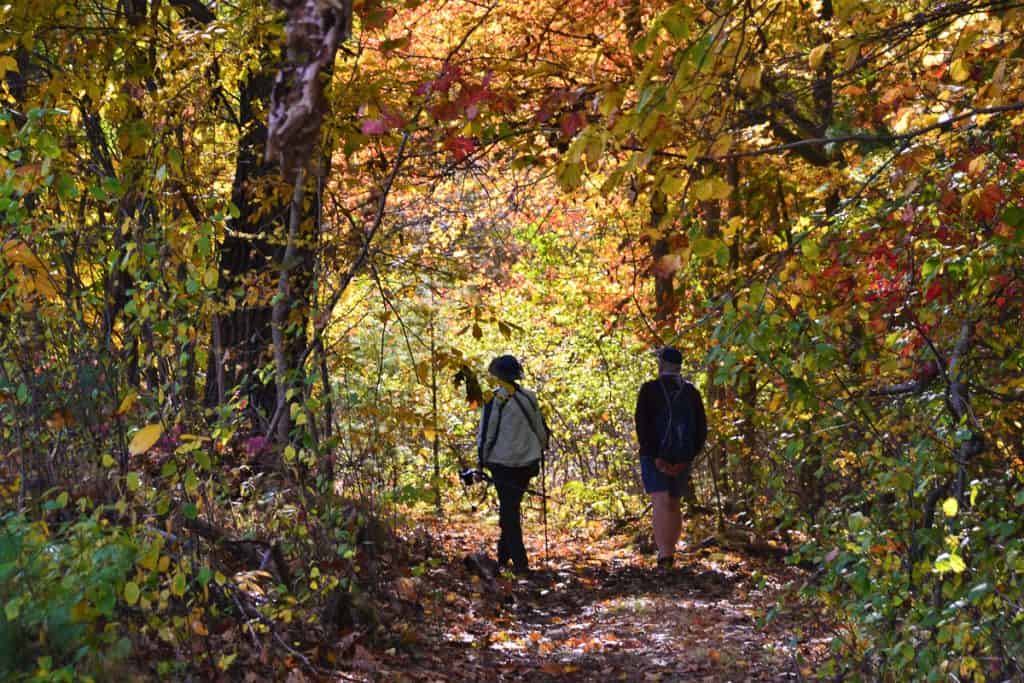A group protests the destruction of 13-plus acres of trees for construction of the new Northeast Metro Tech school
When the vote was taken by Saugus to build a new Northeast Metropolitan Regional Vocational High School to replace the existing one, most of us assumed it would be built on already disturbed land, such as the school’s current football and baseball fields, as had been done when the new Saugus Middle-High was built a few years ago. That had, indeed, been the recommendation from the architects of the 2016 pre-feasibility study for the new Voke School.
But in the meantime, a new location – the undisturbed woods adjacent to the current parking lot and Breakheart Reservation’s Wakefield entrance – has become the chosen location. This will require extensive blasting and removal of trees, destruction of wildlife habitat and the creation of a new 650-foot-long, 30-35-foot-high cliff beside the new school. The cliff will require fencing and ongoing inspections as well as a 12-foot-wide ditch to keep rocks from falling onto the road next to the school.
This mature forest was once part of Breakheart Reservation. But in 1965 it was transferred to the Northeast Metropolitan Regional Vocational School District, which now owns this land.
A fall walk through the forest offers spectacular fall color from the many native tree species, the songs of resident and migrating birds, including golden-crowned and ruby-crowned kinglets, and habitats ranging from forested ledges to vernal pools. Readers of Doug Tallamy’s books – especially “Nature’ Best Hope” and “The Nature of Oaks” – will be pleased to see an abundance of oaks, especially the white oak (Quercus alba), which he calls one of the most essential native trees because of the number of creatures it supports on the food chain.
It seems incredible, especially in the light of 60 acres of Breakheart Reservation’s forest damaged this summer by fires, to contemplate intentional destruction of adjacent forest acreage.
According to Friends of Wakefield’s Northeast Metro Tech Forest (nemtforest.org), one of several groups trying to save the forest and build a school that better serves our students, “An irreplaceable oak and white pine hilltop forest with vernal pools and forested wetlands could be cut as early as March 2023, followed by a massive 6 month operation to excavate an area larger than 2 football fields. Hundreds of oaks and pines will be cut, roots grubbed out and soil removed. Moss and lichen-covered volcanic rock outcrops will be blasted to reduce the height of the hill by as much as 34 ft and the blasted rock will be crushed on site. Spring and Summer of 2023 next to Breakheart Reservation in Wakefield will be filled with noise, vibration and hazardous dust for those walking nearby trails to the lookout at Castle Rock. Those at the lookout will watch the ongoing devastation of rock crushers turning the hillside into fill, while those who live in the area risk potential structural damage from weeks of blasting.”
The new access road alone would impact three vernal pool areas. And while there are plans to replicate these areas elsewhere onsite, the vernal pools would be separated from each other and other wetland areas, making it difficult if not impossible for salamanders and other amphibians dependent on vernal pools to travel from one habitat to the next one that their life cycles demand.
The selection of the hilltop site will create an upper and lower campus separating the new school building on the upper campus from the student parking lot and playing fields on the lower campus. The upper campus will be 60 vertical feet above the lower campus, the equivalent of six stories, and require 10 sets of concrete stairs (100 steps) or over 700 feet of raised, ramped boardwalks to access the upper campus from the lower campus. This will be challenging for everyone, and those with limited mobility will face significant barriers to full participation in campus life. It will also teach the students that removing wildlife habitat and woods is “no big deal” even when there are reasonable alternatives on the property.
Those protesting the forest’s destruction are still in favor of a new Northeast Metropolitan Regional Vocational High School, but want it built on a suitable location that benefits all students and where it will cause less damage to wildlife habitat and water runoff.
Saugus was among the 11 communities that voted overwhelmingly in support of a proposed new Northeast Metro Tech school. Seven percent of the town’s 20,509 registered voters turned out, and about 63 percent of them voted “Yes” on the question of whether to authorize the borrowing of about $317.4 million to pay costs of designing, constructing and equipping a new Northeast Metropolitan Regional Vocational School and related athletic facilities, located at 100 Hemlock Rd. in Wakefield.
Overall, the question prevailed on a lopsided vote – about 83 percent of voters supporting the school project – which has already received an award of $140.8 million from the Massachusetts School Building Authority (MSBA). Only voters in Chelsea – which has the second highest enrollment (238) of the district’s 1,281 students – opposed the project. Of the 283 residents in that city who voted, only 109 (39 percent) voted “Yes.” Saugus, which has 170 students enrolled at Northeast Metro Tech – the third-highest number (13 percent) in the district, had the most voters (1,468) turning out of all of the communities.
Construction of the school is not expected to begin until the spring of 2023, with a targeted completion in early 2026.





